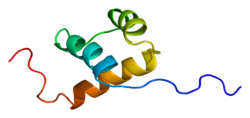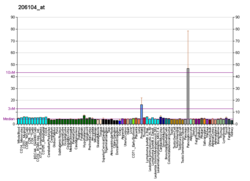
Summary
Insulin gene enhancer protein ISL-1 is a protein that in humans is encoded by the ISL1 gene.[5] [6]
| ISL1 | |||||||||||||||||||||||||||||||||||||||||||||||||||
|---|---|---|---|---|---|---|---|---|---|---|---|---|---|---|---|---|---|---|---|---|---|---|---|---|---|---|---|---|---|---|---|---|---|---|---|---|---|---|---|---|---|---|---|---|---|---|---|---|---|---|---|
 | |||||||||||||||||||||||||||||||||||||||||||||||||||
| |||||||||||||||||||||||||||||||||||||||||||||||||||
| Identifiers | |||||||||||||||||||||||||||||||||||||||||||||||||||
| Aliases | ISL1, ISLET1, Isl-1, ISL LIM homeobox 1 | ||||||||||||||||||||||||||||||||||||||||||||||||||
| External IDs | OMIM: 600366 MGI: 101791 HomoloGene: 1661 GeneCards: ISL1 | ||||||||||||||||||||||||||||||||||||||||||||||||||
| |||||||||||||||||||||||||||||||||||||||||||||||||||
| |||||||||||||||||||||||||||||||||||||||||||||||||||
| |||||||||||||||||||||||||||||||||||||||||||||||||||
| |||||||||||||||||||||||||||||||||||||||||||||||||||
| |||||||||||||||||||||||||||||||||||||||||||||||||||
| Wikidata | |||||||||||||||||||||||||||||||||||||||||||||||||||
| |||||||||||||||||||||||||||||||||||||||||||||||||||
Function edit
This gene encodes a transcription factor containing two N-terminal LIM domains and one C-terminal homeodomain. The encoded protein plays an important role in the embryogenesis of pancreatic islets of Langerhans. In mouse embryos, a deficiency of this gene results in failure to undergo neural tube motor neuron differentiation.[6]
Interactions edit
ISL1 has been shown to interact with Estrogen receptor alpha.[7]
Role in cardiac development edit
ISL1 is a marker for cardiac progenitors of the secondary heart field (SHF) which includes the right ventricle and the outflow tract. The biological function of ISL1 is demonstrated through ISL1 mutant mice and chick embryos that have altered cell proliferation, survival, and migration of cardiogenic precursors and severe cardiac defects.[8] More recently it has been defined as a marker for a cardiac progenitor cell lineage that is capable of differentiating into all 3 major cell types of the heart: cardiomyocytes, smooth muscle and endothelial cell lineages.[9][10][11] Research has shown that ISL1 promotes differentiation of cardiac cells and a depletion of ISL1 can respecify the cell fate of nascent cardiomyocytes, such as from ventricular to an atrial identity. [12]
The validity of ISL1 as a marker for cardiac progenitor cells has been questioned since some groups have found no evidence that ISL1 cells serve as cardiac progenitors.[13] Furthermore, ISL1 is not restricted to second heart field progenitors in the developing heart, but also labels cardiac neural crest.[14] This paper supports work from the Vilquin group in 2011, which concluded that ISL1 can represent cells from both neural crest and cardiomyocyte lineages.[15] While it has been demonstrated by multiple groups that ISL1-positive cells can indeed differentiate into all 3 major cell types of the heart, their significance in cardiovascular development is still unclear and their clinical relevance has been seriously questioned.
References edit
- ^ a b c GRCh38: Ensembl release 89: ENSG00000016082 - Ensembl, May 2017
- ^ a b c GRCm38: Ensembl release 89: ENSMUSG00000042258 - Ensembl, May 2017
- ^ "Human PubMed Reference:". National Center for Biotechnology Information, U.S. National Library of Medicine.
- ^ "Mouse PubMed Reference:". National Center for Biotechnology Information, U.S. National Library of Medicine.
- ^ Tanizawa Y, Riggs AC, Dagogo-Jack S, Vaxillaire M, Froguel P, Liu L, et al. (July 1994). "Isolation of the human LIM/homeodomain gene islet-1 and identification of a simple sequence repeat polymorphism [corrected]". Diabetes. 43 (7): 935–941. doi:10.2337/diabetes.43.7.935. PMID 7912209.
- ^ a b "Entrez Gene: ISL1 ISL1 transcription factor, LIM/homeodomain, (islet-1)".
- ^ Gay F, Anglade I, Gong Z, Salbert G (October 2000). "The LIM/homeodomain protein islet-1 modulates estrogen receptor functions". Molecular Endocrinology. 14 (10): 1627–1648. doi:10.1210/mend.14.10.0538. PMID 11043578.
- ^ Cai CL, Liang X, Shi Y, Chu PH, Pfaff SL, Chen J, Evans S (December 2003). "Isl1 identifies a cardiac progenitor population that proliferates prior to differentiation and contributes a majority of cells to the heart". Developmental Cell. 5 (6): 877–889. doi:10.1016/s1534-5807(03)00363-0. PMC 5578462. PMID 14667410.
- ^ Moretti A, Caron L, Nakano A, Lam JT, Bernshausen A, Chen Y, et al. (December 2006). "Multipotent embryonic isl1+ progenitor cells lead to cardiac, smooth muscle, and endothelial cell diversification". Cell. 127 (6): 1151–1165. doi:10.1016/j.cell.2006.10.029. PMID 17123592. S2CID 31238870.
- ^ Laugwitz KL, Moretti A, Lam J, Gruber P, Chen Y, Woodard S, et al. (February 2005). "Postnatal isl1+ cardioblasts enter fully differentiated cardiomyocyte lineages". Nature. 433 (7026): 647–653. Bibcode:2005Natur.433..647L. doi:10.1038/nature03215. PMC 5578466. PMID 15703750.
- ^ Bu L, Jiang X, Martin-Puig S, Caron L, Zhu S, Shao Y, et al. (July 2009). "Human ISL1 heart progenitors generate diverse multipotent cardiovascular cell lineages". Nature. 460 (7251): 113–117. Bibcode:2009Natur.460..113B. doi:10.1038/nature08191. PMID 19571884. S2CID 801804.
- ^ Quaranta R, Fell J, Rühle F, Rao J, Piccini I, Araúzo-Bravo MJ, et al. (January 2018). "Revised roles of ISL1 in a hES cell-based model of human heart chamber specification". eLife. 7. doi:10.7554/eLife.31706. PMC 5770158. PMID 29337667.
- ^ Weinberger F, Mehrkens D, Friedrich FW, Stubbendorff M, Hua X, Müller JC, et al. (May 2012). "Localization of Islet-1-positive cells in the healthy and infarcted adult murine heart". Circulation Research. 110 (10): 1303–1310. doi:10.1161/CIRCRESAHA.111.259630. PMC 5559221. PMID 22427341.
- ^ Engleka KA, Manderfield LJ, Brust RD, Li L, Cohen A, Dymecki SM, Epstein JA (March 2012). "Islet1 derivatives in the heart are of both neural crest and second heart field origin". Circulation Research. 110 (7): 922–926. doi:10.1161/CIRCRESAHA.112.266510. PMC 3355870. PMID 22394517.
- ^ Khattar P, Friedrich FW, Bonne G, Carrier L, Eschenhagen T, Evans SM, et al. (June 2011). "Distinction between two populations of islet-1-positive cells in hearts of different murine strains". Stem Cells and Development. 20 (6): 1043–1052. doi:10.1089/scd.2010.0374. PMC 5880329. PMID 20942609.
Further reading edit
- Larsson LI (November 1998). "On the development of the islets of Langerhans". Microscopy Research and Technique. 43 (4): 284–291. doi:10.1002/(SICI)1097-0029(19981115)43:4<284::AID-JEMT2>3.0.CO;2-0. PMID 9849969. S2CID 19416265.
- Dong J, Asa SL, Drucker DJ (November 1991). "Islet cell and extrapancreatic expression of the LIM domain homeobox gene isl-1". Molecular Endocrinology. 5 (11): 1633–1641. doi:10.1210/mend-5-11-1633. PMID 1685766.
- Riggs AC, Tanizawa Y, Aoki M, Wasson J, Ferrer J, Rabin DU, et al. (June 1995). "Characterization of the LIM/homeodomain gene islet-1 and single nucleotide screening in NIDDM". Diabetes. 44 (6): 689–694. doi:10.2337/diabetes.44.6.689. PMID 7789634.
- Wang M, Drucker DJ (March 1994). "The LIM domain homeobox gene isl-1: conservation of human, hamster, and rat complementary deoxyribonucleic acid sequences and expression in cell types of nonneuroendocrine lineage". Endocrinology. 134 (3): 1416–1422. doi:10.1210/endo.134.3.7907017. PMID 7907017.
- Pfaff SL, Mendelsohn M, Stewart CL, Edlund T, Jessell TM (January 1996). "Requirement for LIM homeobox gene Isl1 in motor neuron generation reveals a motor neuron-dependent step in interneuron differentiation". Cell. 84 (2): 309–320. doi:10.1016/S0092-8674(00)80985-X. PMID 8565076. S2CID 5780554.
- Bonaldo MF, Lennon G, Soares MB (September 1996). "Normalization and subtraction: two approaches to facilitate gene discovery". Genome Research. 6 (9): 791–806. doi:10.1101/gr.6.9.791. PMID 8889548.
- Ahlgren U, Pfaff SL, Jessell TM, Edlund T, Edlund H (January 1997). "Independent requirement for ISL1 in formation of pancreatic mesenchyme and islet cells". Nature. 385 (6613): 257–260. Bibcode:1997Natur.385..257A. doi:10.1038/385257a0. PMID 9000074. S2CID 4341596.
- Jurata LW, Pfaff SL, Gill GN (February 1998). "The nuclear LIM domain interactor NLI mediates homo- and heterodimerization of LIM domain transcription factors". The Journal of Biological Chemistry. 273 (6): 3152–3157. doi:10.1074/jbc.273.6.3152. PMID 9452425.
- Bach I, Rodriguez-Esteban C, Carrière C, Bhushan A, Krones A, Rose DW, et al. (August 1999). "RLIM inhibits functional activity of LIM homeodomain transcription factors via recruitment of the histone deacetylase complex". Nature Genetics. 22 (4): 394–399. doi:10.1038/11970. PMID 10431247. S2CID 22326394.
- Gay F, Anglade I, Gong Z, Salbert G (October 2000). "The LIM/homeodomain protein islet-1 modulates estrogen receptor functions". Molecular Endocrinology. 14 (10): 1627–1648. doi:10.1210/mend.14.10.0538. PMID 11043578.
- Ostendorff HP, Peirano RI, Peters MA, Schlüter A, Bossenz M, Scheffner M, Bach I (March 2002). "Ubiquitination-dependent cofactor exchange on LIM homeodomain transcription factors". Nature. 416 (6876): 99–103. Bibcode:2002Natur.416...99O. doi:10.1038/416099a. PMID 11882901. S2CID 4426785.
- Holm P, Rydlander B, Luthman H, Kockum I (June 2004). "Interaction and association analysis of a type 1 diabetes susceptibility locus on chromosome 5q11-q13 and the 7q32 chromosomal region in Scandinavian families". Diabetes. 53 (6): 1584–1591. doi:10.2337/diabetes.53.6.1584. PMID 15161765.
- Hori Y, Gu X, Xie X, Kim SK (April 2005). "Differentiation of insulin-producing cells from human neural progenitor cells". PLOS Medicine. 2 (4): e103. doi:10.1371/journal.pmed.0020103. PMC 1087208. PMID 15839736.
- Takeuchi JK, Mileikovskaia M, Koshiba-Takeuchi K, Heidt AB, Mori AD, Arruda EP, et al. (May 2005). "Tbx20 dose-dependently regulates transcription factor networks required for mouse heart and motoneuron development". Development. 132 (10): 2463–2474. doi:10.1242/dev.01827. hdl:10393/12782. PMID 15843409.
- Peng SY, Wang WP, Meng J, Li T, Zhang H, Li YM, et al. (December 2005). "ISL1 physically interacts with BETA2 to promote insulin gene transcriptional synergy in non-beta cells". Biochimica et Biophysica Acta (BBA) - Gene Structure and Expression. 1731 (3): 154–159. doi:10.1016/j.bbaexp.2005.08.013. PMID 16321656.
External links edit
- ISL1+protein,+human at the U.S. National Library of Medicine Medical Subject Headings (MeSH)
This article incorporates text from the United States National Library of Medicine, which is in the public domain.







